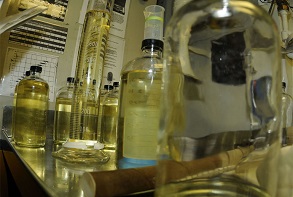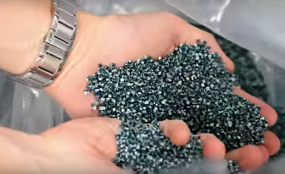At first there was just LanzaTech, about which we wrote four years ago. Now there are many others: Newlight Technologies, INEOS Bio, Mango Materials. Companies that develop gas fermentation, using gases like methane or syngas and processing them with microorganisms. Others have tried and failed, in particular those that concentrated on fuels, rather than on specialty chemicals and materials: Range Fuels, Coskata. Still, the sector’s achievements are remarkable.
 Gas fermentation: the essentials
Gas fermentation: the essentials
Gas fermentation consists of microbiological treatment of gases that serve as a source of carbon, like carbon monoxide, carbon dioxide, methane or syngas. The gases are led through a reactor containing microorganisms that process the gas to the desired product. Syngas mainly consists of carbon monoxide and hydrogen; it is the product of heating biomass waste (or any waste that contains much carbon, like municipal waste) to 1000 oC with a little oxygen. Syngas is much used in petrochemical industry; biological treatment of biobased syngas is new. LanzaTech’s successes are based on the treatment of blast furnace waste gases, that contain much carbon monoxide. Mango Materials and Newlight Technologies use sources of methane like emissions from farms, water treatment plants and landfills. Many of these emissions are air-bound if we do not intervene, and as methane is a much more potent greenhouse gas than carbon dioxide, there is a lot to win here. Methane processing is relatively easy, as many of these processes will produce rather than require energy.
Waste feedstocks
LanzaTech remains by far the biggest company in this sector. Originally from New Zealand, it was persuaded with a lot of money to move its headquarters from Auckland to Chicago, with the intention to kindle the wavering economy of Illinois. Alter many years of preparation and testing, LanzaTech is now finally ready for three commercial plants on steel making companies’ sites: in China with Shougang; in Taiwan with China Steel and in Belgium with the world’s largest steel maker, ArcelorMittal. One of the main products is 2,3-butanediol, a chemical used for the production of nylon and rubber. As LanzaTech starts out with waste gases, its products are not in competition with food production (in fact, none of the products mentioned in this article). In another branch of LanzaTech’s activities, it developed a gas fermentation process from syngas. In March this year it signed a licensing agreement with Aemetis, a Californian advanced fuels and renewable chemicals company. With this technology, Aemetis will convert agricultural waste, forest waste, dairy waste and construction and demolition waste (CDW) to ‘advanced’ ethanol, planning to reduce feedstock costs from more than $ 150 a ton to receiving tipping fees for waste feedstocks.

Equally astonishing is the project of Newlight Technologies to capture methane and process it, together with atmospheric oxygen, to a polymer material that they call AirCarbon, a ‘PHA-based thermoplastic’ according to their website. AirCarbon, according to Newlight, can ‘meet the performance requirements of a wide range of applications, including applications currently using fossil fuel-based polypropylene, polyethylene, ABS, polystyrene, and TPU.’ Last March, Newlight signed a supply, collaboration and technology license agreement with IKEA. Under the agreement, IKEA will purchase 50% of the material from Newlight’s 23 kton per year plant in the United States; IKEA will have exclusive rights in the home furnishings industry to use Newlight’s technology for use in its products. The long term goal is to develop capacities up to 453 kton or 1 billion pounds per year.
Gas fermentation pilots
Mango Materials is smaller and still in the phase of pilots, but its methane-to-PHB technology has won many prizes and is looked upon as very promising. PHB is the most common of PHAs, a naturally occurring and biodegradable polymer. It is very versatile and can be used in a large range of products, from children’s toys to packaging. The main obstacle being price, Mango Materials puts a lot of effort in driving price down. It can construct its facilities right on the location of the methane producer and thereby reduce transport costs. It envisages to construct many facilities on as many sources of waste methane (abandoned coal mines, wastewater treatment and biogas facilities etc.), producing eco-friendly and affordable materials with a positive environmental impact.
A few companies that tried to produce ethanol or other fuels by gas fermentation have gone out of business as oil prices fell. INEOS Bio still hangs on, it produces bioethanol from biobased syngas. Coskata, that tried to develop methane fermentation to produce fuels, has stopped; but re-emerged as Synata Bio that might try to produce more attractive chemicals like acetic acid, propanol or n-butanol. Summing up, gas fermentation is a promising technology, in particular for the production of specialty chemicals and materials. And as it uses toxic or greenhouse gases as its feedstock, it might do mankind a lot of good as well.
Interesting? Then also read:
PHA: promising, versatile, biodegradable
Biofuels without agro
Towards a smaller scale in the biobased economy. But why, and to what extent?

Dear all,
we are interested in placing your technology for a biogas plant.
Could you give us information, whether or not, biogas (e.g. Methane 50- 60 % apart from CO2 ) is suitable ? We would like to do this in decentralised reactor prone to a biogas plant.
Walter Holweger